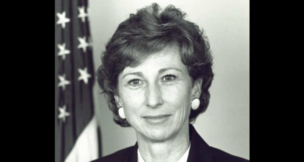Thomas’ case straddles old, new Bar discipline systems
Gary Grado//March 11, 2011//[read_meter]

No doubt to his dismay, former Maricopa County Attorney Andrew Thomas is shining a high-beam light on Arizona’s new system of disciplining attorneys.
The system, which took effect Jan. 1, eliminated steps from the process and added more laymen to the decision-making, and is so new that Thomas is only the second lawyer to be strapped with a complaint.
Thomas and his former deputies Lisa Aubuchon and Rachel Alexander are facing 32 counts of alleged ethical misconduct stemming from his two-year power struggle with the Maricopa County Board of Supervisors and Maricopa County Superior Court. The complaint was filed Feb. 3, and a special investigator for the State Bar has recommended disbarment for Thomas and Aubuchon.
Since it began in March 2010, the case has combined parts of the new and the old system. In fact, Thomas’ and Alexander’s attorneys are challenging decisions that came before the change.
They have filed motions with Presiding Disciplinary Judge William O’Neil asking him to let the Probable Cause Committee, established under the new system, review the case and decide if it should go forward. The Probable Cause Committee comprises six lawyers and three non-lawyers.
Under the previous rules, a single person known as the probable cause panelist, who was a member of the State Bar of Arizona’s Board of Governors, did the job of the new committee. To avert appearances of conflict of interest in Thomas’ case, the Supreme Court appointed retired Supreme Court Justice Charles Jones to serve as the probable cause panelist.
“To state the obvious, a review by nine individuals will lead to a significantly more thorough and thoughtful review of the evidence and recommendations made by the investigator,” wrote Alexander’s attorney, Scott Zwillinger, in a motion to O’Neil seeking to send the complaint to the newly created committee.
Zwillinger wrote that the probable cause panelist’s job was to either ratify or reject the investigator’s recommendation, but the committee can decide whether more investigation is needed, whether the accused should be put in a diversion program, or whether lesser forms of discipline are appropriate. Jones recommended on Dec. 6 that formal complaints be lodged against Thomas and his former staffers.
O’Neil, speaking generally and not specifically about the Thomas case, said the Probable Cause Committee should bring more transparency to the system because its proceedings are recorded and public members are involved in the decision-making.
Probable cause panelists did their work privately, and there was scant record of the reasoning for their decisions.
Trying to persuade O’Neil to let the committee review the case could be futile, however.
In establishing the new system, the Arizona Supreme Court decided that all pending cases will transfer to the new rules except for those that had already received a hearing before
Dec. 31. Thomas, Aubuchon and Alexander had not had any hearings, so the case against them is operating under the new system.
O’Neil held a scheduling conference in that case
March 9. During the meeting, O’Neil scheduled an April 14 meeting to address whether media should be permitted to film and take photographs during future proceedings, and to establish a more detailed time frame for handling the case.
If Thomas’ case had been under the old system, his next step after the probable cause panelist’s decision would have been a hearing in front of a hearing officer, who would have taken testimony and evidence and made a recommendation for sanctions.
Then, under the old system, a nine-member Disciplinary Commission would hear his case. The commission could do any number of things, including sending the case back to the hearing officer or inserting its own judgment in place of the hearing officer’s judgement. The commission would write its own report and make a recommendation to the Arizona Supreme Court, which had final say.
“What you had was a really prolonged process, where it wouldn’t be unusual for these cases to go two years, three years to get resolution. I’ve seen a couple files that went over five years,” O’Neil said. “For a member of the public, I think any regulatory process that would take you two, three, four, five years to resolve is difficult to tolerate.”
The hearing officers and Disciplinary Commission have been replaced by a single Hearing Panel, made up of O’Neil, a lawyer and a non-lawyer. Their ruling is final, though it can be appealed to the Supreme Court.
O’Neil said the new system, which is modeled after Colorado’s procedures for disciplining attorneys, puts a lot of emphasis on resolving cases on the front end.
Rick DeBruhl, a spokesman for the State Bar of Arizona, said the organization now has the ability to resolve minor complaints informally. For instance, the most frequent complaint is that an attorney won’t return a client’s calls, which the bar can usually resolve with a few phone calls.
But under the old system, letters were drafted and responses from the attorneys were required, DeBruhl said.
The State Bar placed Andrew Thomas under investigation last year after Pima County Superior Court Judge John Leonardo found that he had abused his power in the investigation and prosecution of Maricopa County Supervisor Mary Rose Wilcox. The Supreme Court appointed John Gleason, who heads Colorado’s attorney regulation system, to lead the investigation, and he issued his report Dec. 6, the same day Jones issued his recommendation.
Thomas, Aubuchon and Alexander abused their prosecutorial powers by retaliating against and intimidating Thomas’ enemies to further the county attorney’s political self-interest, Gleason alleged.
All of the allegations of ethical violations stem from the series of disputes, criminal prosecutions and lawsuits that Thomas brought against his political rivals — and judges who ruled against him in various cases — during a four-year period while he was in charge of the County Attorney’s Office. All of the criminal cases and lawsuits brought by Thomas were dismissed.
Thomas resigned from office April 6 to enter the Republican primary for attorney general. He lost to Tom Horne, who won the job in the November general election.
After 20 years, O’neil slips into a new judging role
Arizona’s system for disciplining lawyers used to be a scaffolding of individual decision-makers and committees that would take years to sanction someone for misconduct.
The new system, modeled after Colorado’s and in effect since Jan. 1, shed the intricacies and gained a point man.
Most serious, contested cases will now go through Presiding Disciplinary Judge William O’Neil, who, after 20 years on the Superior Court bench in Pinal County, is the Arizona Supreme Court’s choice to administer justice to State Bar of Arizona members accused of misdeeds.
“My directive from the Supreme Court was this is a new thing we’ve created,” O’Neil said. “They said, ‘Look Bill, we’re giving you the skeleton, you put the muscles, the organs, the flesh, the skin on it so this walks and talks and does what we need it to do.’”
One of the things that needed to be done was to speed up cases. Rick DeBruhl, spokesman for the State Bar, said the average case took about 22 months to resolve.
O’Neil said he has seen files that took up to five years.
There aren’t many rules governing the attorney discipline process, so O’Neil said he has latitude to make sure cases run smoothly.
From Superior Court, O’Neil brought techniques in efficient case processing, such as a strict adherence to hearing dates and mandatory settlement conferences.
He also requires that the attorneys involved in settlement conferences have full authority to settle at the table.
Even if a case doesn’t settle, attorneys tend to narrow the contested issues, which saves time at later hearings, he said.
O’ Neil has been busy wrapping up the 27 cases that began in the old system and were transferred to the new.
So far, only a handful of complaints have been filed in the new system, but they include cases involving former Maricopa County Andrew Thomas and two of his former deputies, and one filed March 1 against Apache County Attorney Michael Whiting and his top deputy, Martin Brannan.
Attorneys who regularly defend their counterparts accused of misconduct have favorable impressions of the new system, but they add that awarding it a seal of approval is premature.
“My impression is it is working as well as one could expect for a new system with which most of us are unfamiliar,” attorney Mark Harrison said. “My impression is the new PDJ (presiding disciplinary judge) has jumped in and is doing a really excellent job.”
Harrison said the goal of the new system was to distinguish more sharply between cases that involved serious and minor misconduct, and to resolve cases earlier in the process.
“That premise seems to be operating in practice,” Harrison said.
O’Neil, who commutes daily by car and bus from Casa Grande to his Phoenix office, said he was preparing to retire from the bench and go into private practice when he learned about the job opening while at a meeting at the Supreme Court on an unrelated matter.
He said the job was attractive because it was a culmination of his work on the bench, his participation on various judicial committees, and his efforts at improving the courts, such as his successful petitioning to the Supreme Court for rule changes in the juvenile justice system.
And what he has seen so far in the attorney discipline cases has sometimes left him scratching his head as to why people put themselves in such compromising situations as sleeping with clients and spouses of clients.
But cases in which people have given in to addiction and drinking and a tsunami of life circumstances have evoked his empathy.
There was a reinstatement case that left him moved after it was clear that the attorney turned his life around.
“I stood up and applauded that attorney,” O’Neil said.

















